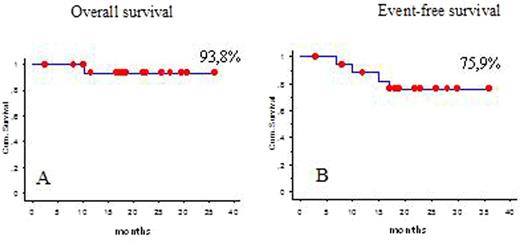Abstract
Background: The number of elderly patients with diffuse large B-cell lymphoma (DLBCL) in our aging society continues to rise. Median of age for patients with diffuse large B-cell lymphoma (DLBCL) is 60. Approximately 50% of older patients with DLBCL are defined as high-grade by IPI and these forms are characterized by aggressive course and poor response to standard chemotherapy (CT). Intensive protocols cannot be performed due to their toxicity for older patients with comorbidity. Addition of R-HMA to R-DA-EPOCH favourably changes the outcome in patients with untreated high-grade diffuse large B-cell lymphoma and didn't have higher toxicity [ASH 2015 # 2708].
Aim: To evaluate the efficacy and toxicity of R-EPOCH/R-HMA protocol in older patients with untreated high-grade diffuse large B-cell lymphoma.
Patients and Methods: 19 untreated older DLBCL patients from 4 centers were enrolled in a prospective study between August 2013 - July 2016; stage II-IV; ECOG 0-3; median age 66 years (60-78); age ≥70y/60<70y 21%/79%; M/F 52%/48%; IPI: 52% high-intermediate and 48% high risk; 26% with bone marrow involvement. Severe comorbidity was diagnosed in 8 (42%) patients (coronary heart disease, hypertonic disease, chronic obstructive pulmonary disease and arrhythmia). All patients underwent 4-6 courses (2-3 cycles) of chemotherapy: R-EPOCH (standard dose and scheme), R-HMA (R 375 mg/m2 d1, MTX 500 mg/m2 24 hours d 2, AraC 1000 mg/m2 q 12 hrs d 3-4). In 3 cases of DLBCL with bone marrow involvement BEAM conditioning and autologous stem cell transplantation were applied.
Results: The median follow-up is 18 months (3-37). There was no mortality associated with toxicity. The main non-hematological toxicities of R-HMA were infections (mucositis, pneumonia, sepsis, enteropathy) grades 1-2 and 3-4 in 90% and 10%, respectively. Hematological toxicity grade 4 for less than 4 days we observed only after courses R-HMA. Complete remission (CR) was achieved in 18 (100%) patients and 1 patient in the treatment now. There are four failures in patients older than 60 years: three relapses (after 6 and two after 14 month CR) and one death after 7 month CR by reasons not related with DLBCL.
With a median follow 18 months overall and event-free survival of 19 older patients constituted 93,8% and 75,9%, respectively (Fig.1). There is no difference in older patients according to stage, IPI, LDH level, ECOG status for OS and EFS. So the combination of R-EPOCH/R-HMA may be considered as optimal intensive approach in older patients.
Conclusions: TheR-EPOCH/R-HMA protocol demonstrated acceptable toxicity and high efficacy in older patients with high-grade DLBCL.
Overall (A) and Event-free (B) survival in elderly patients with DLBCL.
No relevant conflicts of interest to declare.
Author notes
Asterisk with author names denotes non-ASH members.


